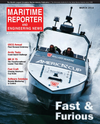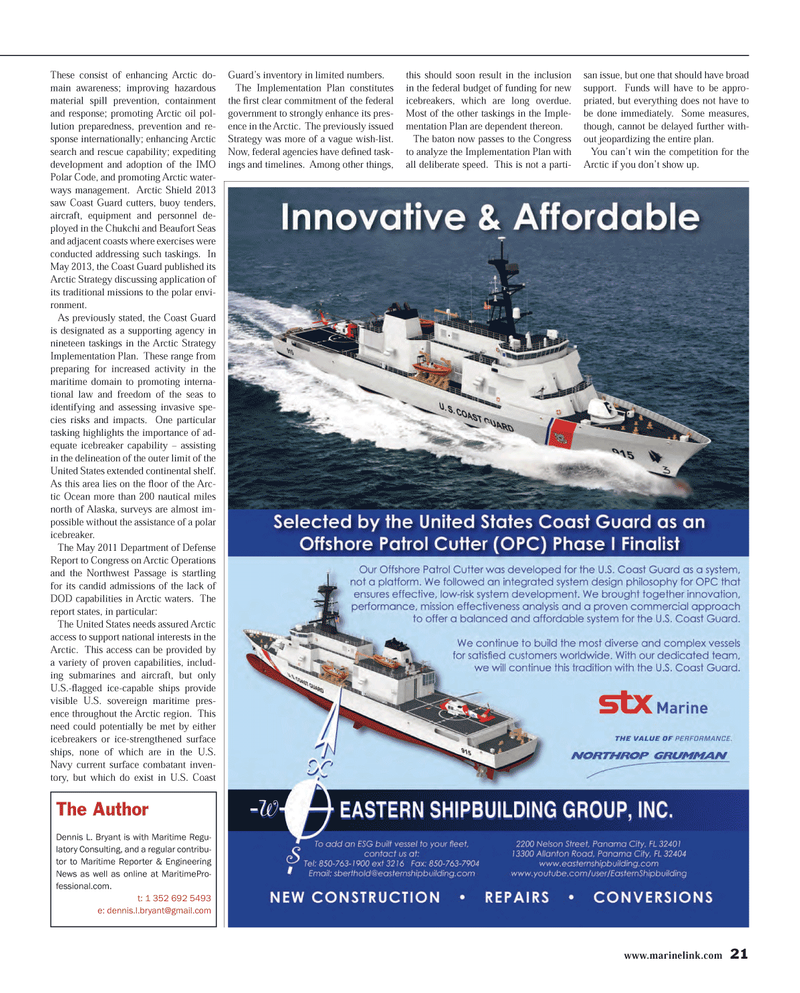
Page 21: of Maritime Reporter Magazine (March 2014)
U.S. Coast Guard Annual
Read this page in Pdf, Flash or Html5 edition of March 2014 Maritime Reporter Magazine
www.marinelink.com 21
These consist of enhancing Arctic do- main awareness; improving hazardous material spill prevention, containment and response; promoting Arctic oil pol- lution preparedness, prevention and re- sponse internationally; enhancing Arctic search and rescue capability; expediting development and adoption of the IMO
Polar Code, and promoting Arctic water- ways management. Arctic Shield 2013 saw Coast Guard cutters, buoy tenders, aircraft, equipment and personnel de- ployed in the Chukchi and Beaufort Seas and adjacent coasts where exercises were conducted addressing such taskings. In
May 2013, the Coast Guard published its
Arctic Strategy discussing application of its traditional missions to the polar envi- ronment.
As previously stated, the Coast Guard is designated as a supporting agency in nineteen taskings in the Arctic Strategy
Implementation Plan. These range from preparing for increased activity in the maritime domain to promoting interna- tional law and freedom of the seas to identifying and assessing invasive spe- cies risks and impacts. One particular tasking highlights the importance of ad- equate icebreaker capability – assisting in the delineation of the outer limit of the
United States extended continental shelf.
As this area lies on the fl oor of the Arc- tic Ocean more than 200 nautical miles north of Alaska, surveys are almost im- possible without the assistance of a polar icebreaker.
The May 2011 Department of Defense
Report to Congress on Arctic Operations and the Northwest Passage is startling for its candid admissions of the lack of
DOD capabilities in Arctic waters. The report states, in particular:
The United States needs assured Arctic access to support national interests in the
Arctic. This access can be provided by a variety of proven capabilities, includ- ing submarines and aircraft, but only
U.S.-fl agged ice-capable ships provide visible U.S. sovereign maritime pres- ence throughout the Arctic region. This need could potentially be met by either icebreakers or ice-strengthened surface ships, none of which are in the U.S.
Navy current surface combatant inven- tory, but which do exist in U.S. Coast
Guard’s inventory in limited numbers.
The Implementation Plan constitutes the fi rst clear commitment of the federal government to strongly enhance its pres- ence in the Arctic. The previously issued
Strategy was more of a vague wish-list.
Now, federal agencies have defi ned task- ings and timelines. Among other things, this should soon result in the inclusion in the federal budget of funding for new icebreakers, which are long overdue.
Most of the other taskings in the Imple- mentation Plan are dependent thereon.
The baton now passes to the Congress to analyze the Implementation Plan with all deliberate speed. This is not a parti- san issue, but one that should have broad support. Funds will have to be appro- priated, but everything does not have to be done immediately. Some measures, though, cannot be delayed further with- out jeopardizing the entire plan.
You can’t win the competition for the
Arctic if you don’t show up.
The Author
Dennis L. Bryant is with Maritime Regu- latory Consulting, and a regular contribu- tor to Maritime Reporter & Engineering
News as well as online at MaritimePro- fessional.com. t: 1 352 692 5493 e: [email protected]
MR #3 (18-25).indd 21 3/5/2014 12:08:39 PM

 20
20

 22
22
